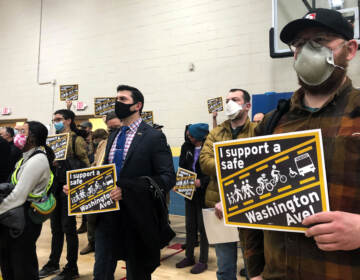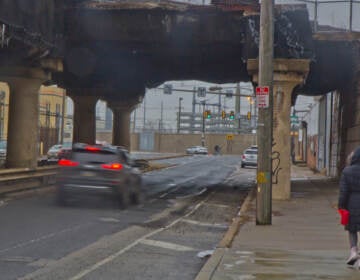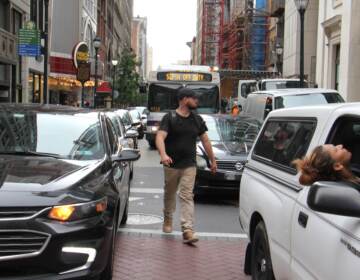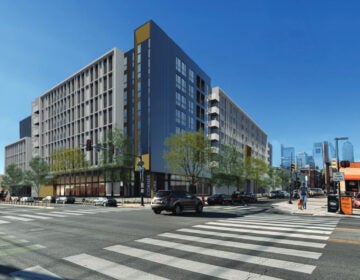Latest wrench in the plan to narrow Washington Ave. has some cheering, others fuming
In a bitter fight over the width of a road in South Philly, a City Council member deals a blow to the plan favored by bicycle and pedestrian safety advocates.
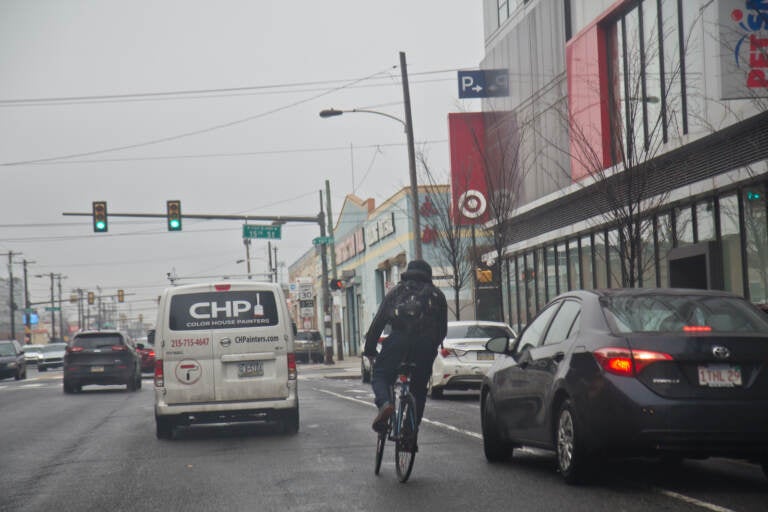
Washington Avenue in South Philadelphia. (Kimberly Paynter/WHYY)
In a bitter fight over the width of a busy thoroughfare in South Philadelphia, a City Council member has dealt a blow to the plan favored by bicycle and pedestrian safety advocates.
Citing conversations with residents and business owners, Councilmember Kenyatta Johnson decided not to introduce parking legislation that transportation officials hoped would facilitate narrowing Washington Avenue. Instead, he announced his support for keeping the road five lanes wide in his district.
“I support installing needed safety protections along Washington Avenue which includes things like speed cushions, curb cuts, better lighting and traffic signals, and more school crossing guards at key locations to make sure children get across the road safer, and keep the current bike lanes on both sides,” Johnson said in an emailed statement. “I think all of these safety improvements can be done and keep Washington Avenue a five-lane road only throughout the Second Council District.”
Johnson’s district covers Washington Avenue between Broad Street and Grays Ferry Avenue, plus just the north side of the street between Broad and 11th street.
The rest of the project area is in Councilmember Mark Squilla’s district. Squilla introduced a bill authorizing the city to revise parking regulations on the portion of the road within his district during Council’s meeting Thursday, which was likely the last day for council members to introduce legislation that could pass before Council’s summer recess begins in late June.
Officials with the city’s OTIS are urging Johnson to amend Squilla’s legislation to include Johnson’s district.
City transportation planners had hoped to narrow sections of Washington Avenue to four and three lanes as early as this summer, to make the road safer for people walking, biking, and driving.
Officials announced the latest three-, four-, and five-lane design — considered a “hybrid” solution — in March, nearly two years after releasing a narrower “final design decision.” Deputy Managing Director for Transportation, Infrastructure, and Sustainability (OTIS) Mike Carroll said that before the city could implement the lane reconfiguration, he wanted to see Council approve changes to parking and loading regulations that would encourage more turnover of parked vehicles.
In order for the project to happen this summer, the legislation would need to make it through Council by its last meeting in June. In order to hold public hearings and two formal readings in Council, the introduction of needed legislation at Thursday’s meeting was possibly the last chance to meet that deadline.
Some longtime residents of the neighborhood and business owners have opposed the plan to narrow the road, fearing it would cause traffic pile-ups and push large trucks onto nearby residential streets.
“The Washington Avenue project was designed comprehensively with each element integral to an overall design to improve safety and supporting a healthy business corridor,” said OTIS spokesperson Joy Huertas in an emailed statement Friday. “The City’s analysis has shown the need for increased parking and loading options to maintain a consistent flow of people in vehicles, including people taking the bus.”
Johnson’s move sets up the potential for a situation in which OTIS enacts the road narrowing on just part of Washington Avenue, in Squilla’s district, and repaves the part in Johnson’s district with the existing lane configuration.
The plan to narrow Washington Avenue ignited the tensions of a gentrifying neighborhood and highlighted the limitations of the city’s public outreach process.
Leadership at OTIS admitted early this year that long-term residents of color were underrepresented in an online survey about the project. The city launched a series of quasi-closed meetings with Registered Community Organizations (RCOs), residents, businesses, and advocacy groups last year, to try to gather more input. It was after these that OTIS announced the hybrid design, which some residents still found too narrow.
“I’m thankful that the Councilman is hearing the people in the community … that Washington Avenue needs to stay as is,” said Annette Randolph, who has lived near Washington Avenue for more than six decades.
Randolph would like to see improvements to Washington Avenue, such as repaving, new lighting, and new sidewalks. But she’s concerned that any narrowing could cause problems for emergency services.
“OTIS and others have not consulted or have even thought about the old-time residents, the people that have been here for years,” she said.
Tom Donatucci, managing partner of the Washington Avenue Property Owners Association and owner of properties housing a plumbing supply store, a hip brewery, and a veterinary hospital on Washington Avenue, is also happy with the latest development. He opposes anything narrower than four lanes.
“It’s a traffic jam,” he said. “From the business perspective, it prevents deliveries.”
But the latest development has infuriated fans of the narrowest design, who feel safety is being thrown out the window.
“I think it’s really ridiculous what [Johnson’s] doing,” said Joe Cox, a bike courier, and bike safety advocate. “It shows clearly that he doesn’t really have a real care for a lot of his constituents in his district.”
Cox and others, including Daniel McGlone, a resident of the Graduate Hospital neighborhood near Washington Avenue and a member of the South of South Neighborhood Association board of directors, say OTIS should go ahead with the mixed lane configuration regardless of Johnson’s position.
“The community has come out and they have overwhelmingly supported the mixed-lane plan that OTIS put forward,” McGlone said. “I think the city should move forward with that plan. Really, there’s nothing that the council member did that would not permit them to do that.”
WHYY is your source for fact-based, in-depth journalism and information. As a nonprofit organization, we rely on financial support from readers like you. Please give today.




